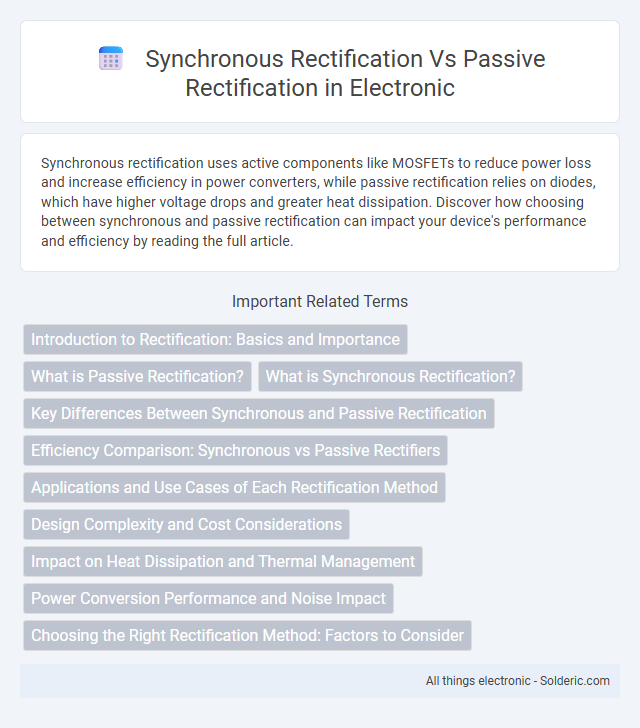Synchronous rectification uses active components like MOSFETs to reduce power loss and increase efficiency in power converters, while passive rectification relies on diodes, which have higher voltage drops and greater heat dissipation. Discover how choosing between synchronous and passive rectification can impact your device's performance and efficiency by reading the full article.
Comparison Table
| Feature | Synchronous Rectification | Passive Rectification |
|---|---|---|
| Rectifying Component | Active MOSFET switches | Diodes (Silicon or Schottky) |
| Efficiency | Higher efficiency (up to 95%+) | Lower efficiency (typically 70%-85%) |
| Voltage Drop | Low voltage drop (mV range) | Higher voltage drop (~0.3V to 0.7V) |
| Power Loss | Reduced conduction losses | Higher conduction losses |
| Complexity | More complex control circuitry required | Simple, no control needed |
| Cost | Higher cost due to extra components | Lower cost, fewer components |
| Operating Frequency | Suitable for high-frequency applications | Less efficient at high frequencies |
| Applications | Switched-mode power supplies, DC-DC converters | General-purpose rectification, low-cost power supplies |
Introduction to Rectification: Basics and Importance
Rectification converts alternating current (AC) to direct current (DC), essential for powering electronic devices and ensuring stable voltage supply. Synchronous rectification employs active components like MOSFETs to reduce conduction losses and improve efficiency, especially in low-voltage, high-current applications. Passive rectification relies on diodes, which are simpler but exhibit higher voltage drops, leading to greater power dissipation and less overall efficiency.
What is Passive Rectification?
Passive rectification uses diodes to convert alternating current (AC) to direct current (DC), relying on semiconductor components that have fixed voltage drops, typically around 0.7 volts for silicon diodes. This method is widely used in low-cost, low-power applications but suffers from efficiency losses due to the diode's forward voltage drop, which generates heat and reduces overall power conversion efficiency. In contrast to synchronous rectification, passive rectification does not employ active switching devices like MOSFETs, limiting its efficiency especially in high-current or low-voltage scenarios.
What is Synchronous Rectification?
Synchronous rectification is a power conversion technique that uses actively controlled MOSFETs instead of traditional diodes to reduce conduction losses and improve efficiency in power supplies. This method replaces the passive rectifier's diode drop with a low-resistance switch, significantly enhancing performance in low-voltage, high-current applications such as DC-DC converters. Key benefits include reduced heat dissipation and higher overall energy efficiency, making synchronous rectification essential in modern electronics design.
Key Differences Between Synchronous and Passive Rectification
Synchronous rectification uses actively controlled MOSFETs to replace diodes, significantly reducing conduction losses and improving efficiency compared to passive rectification, which relies on diodes with higher forward voltage drops. Your power conversion designs benefit from synchronous rectifiers in low-voltage, high-current applications due to lower power dissipation and better thermal performance. Passive rectification remains simpler and less costly but is less efficient, making it ideal for less demanding power conditions where efficiency is not critical.
Efficiency Comparison: Synchronous vs Passive Rectifiers
Synchronous rectifiers offer significantly higher efficiency compared to passive rectifiers by replacing diodes with low-resistance MOSFETs, reducing conduction losses especially at low voltage and high current applications. Passive rectifiers, typically using standard diodes, produce greater voltage drops and heat dissipation, which lowers overall system efficiency. To optimize Your power supply design, choosing synchronous rectification can dramatically improve energy savings and thermal performance.
Applications and Use Cases of Each Rectification Method
Synchronous rectification is predominantly used in high-efficiency power supplies such as DC-DC converters for computer motherboards, LED drivers, and telecom equipment, where reducing conduction losses is critical. Passive rectification finds broad application in simple AC-to-DC adapters, low-power chargers, and automotive battery chargers due to its low cost and simplicity. Each method is selected based on efficiency requirements, cost constraints, and power levels, with synchronous rectification favored for high-performance electronics and passive rectification suited for budget-sensitive or low-power applications.
Design Complexity and Cost Considerations
Synchronous rectification involves active semiconductor switches controlled by integrated circuits, leading to higher design complexity and increased development costs compared to passive rectification, which uses simple diode components. The complexity of synchronous rectifiers enables greater efficiency and reduced power losses but requires precise gate drive circuitry and thermal management, raising manufacturing expenses. Passive rectifiers are cost-effective and straightforward to implement but sacrifice efficiency and may incur higher energy costs over time due to diode voltage drops.
Impact on Heat Dissipation and Thermal Management
Synchronous rectification significantly reduces conduction losses compared to passive rectification by using low-resistance MOSFETs instead of diodes, resulting in lower heat generation and improved thermal efficiency. This reduction in power dissipation simplifies heat sink design and enhances overall thermal management in power supplies. Passive rectification, relying on diodes with higher forward voltage drops, produces greater heat dissipation that requires more robust cooling solutions to maintain reliable device operation.
Power Conversion Performance and Noise Impact
Synchronous rectification delivers higher power conversion efficiency by replacing diodes with actively controlled MOSFETs, reducing conduction losses significantly compared to passive rectification. This efficiency gain minimizes heat dissipation and improves thermal performance, which is critical for high-current applications. Your system also benefits from lower electromagnetic interference (EMI) and reduced switching noise due to the smoother voltage transitions of synchronous rectifiers versus the abrupt diode conduction in passive rectifiers.
Choosing the Right Rectification Method: Factors to Consider
Choosing the right rectification method depends on efficiency requirements, power levels, and application constraints. Synchronous rectification offers lower conduction losses and higher efficiency, making it suitable for high-current and low-voltage applications. Passive rectification, while simpler and cost-effective, is preferred in designs where minimal complexity and lower switching losses are prioritized despite higher conduction losses.
Synchronous rectification vs Passive rectification Infographic

 solderic.com
solderic.com